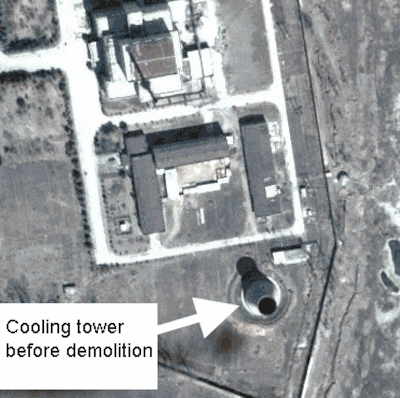North Korea is rebuilding a nuclear site it had formerly used to produce weapons-grade plutonium for its atomic arsenal, according to South Korea’s Defense Ministry.
The construction comes as the reclusive nation puts in place what analysts see as a leadership succession plan.
"North Korea is restoring nuclear facilities and continuing maintenance activities at Yongbyon," Defense Minister Kim Tae Young told South Korea’s parliament Monday.
The statement comes following a brief issued by the Washington-based Institute for Science and International Security (ISIS) which concluded that North Korea had begun new construction activity around the site of a reactor cooling tower it destroyed two years ago.
The tower had been demolished in a June 2008 controlled explosion as part of an agreement made during now-stalled denuclearization talks involving six nations.
ISIS said satellite imagery taken on Sept. 29 “shows new construction or excavation activity in the area surrounding the destroyed cooling tower for the 5MW reactor.”
Scrutiny of the satellite image reveals “heavy machinery tracks as well as trucks and heavy construction or excavation equipment at the site,” according to the brief, which adds that the construction of two small buildings can also be seen adjacent to the destroyed cooling tower.
ISIS researchers David Albright and Paul Brannan said there is no indication that the North Koreans are rebuilding the cooling tower and that the purpose of the activity could not be determined from the imagery, but cautioned that development at the site “bears watching.”
“The size of the excavation almost seems too big for building the type of the cooling tower that they had imploded before,” said Brannan.
“I’ve watched Yongbyon for several years now and I’ve seen them deconstruct and reconstruct an entire portion of their reprocessing building. They take it all in stride. So you never can tell what they’re doing when it comes to construction activity at Yongbyon,” he said.
“But…the fact that they were doing it almost right next to where the cooling tower was imploded—that’s where the concern came from.”
Yongbyon facility

On June 27, 2008, North Korea imploded the most visible symbol of its nuclear weapons development program, the 26-meter-tall (60-foot-tall) concrete cooling tower of the Yongbyon reactor, before an audience comprised of international journalists and diplomats.
The role of the cooling tower was to carry off heat generated through nuclear fission into the atmosphere.
After six-party talks stalled in December 2008 over ways to verify North Korea's denuclearization process, Pyongyang said it had resumed reprocessing spent fuel rods to make plutonium and in May 2009 conducted a second nuclear weapon test.
North Korea is estimated to possess just less than 80 pounds of plutonium.
The construction activity comes against the backdrop of what analysts see as the beginning of North Korea’s power succession.
The official Korean Central News Agency reported Tuesday that North Korean leader Kim Jong Il and his son Kim Jong Un attended a military exercise in what was believed to be the latter’s first public appearance since being promoted to the rank of four-star general last week.
Kim Jong Un, believed to be about 27 and Kim Jong Il’s youngest son, is widely seen as heir apparent to the reclusive Stalinist state.
North Korea's Vice-Minister of Foreign Affairs Pak Kil Yon, speaking before the United Nations Wednesday, vowed Pyongyang would strengthen its nuclear weapons stockpile in order to deter what he called a U.S. and South Korean military buildup in the region.
"As long as the U.S. nuclear aircraft carriers sail around the seas of our country, our nuclear deterrent can never be abandoned but should be strengthened further," Pak said. "This is the lesson we have drawn."
Original reporting by Joshua Lipes.
